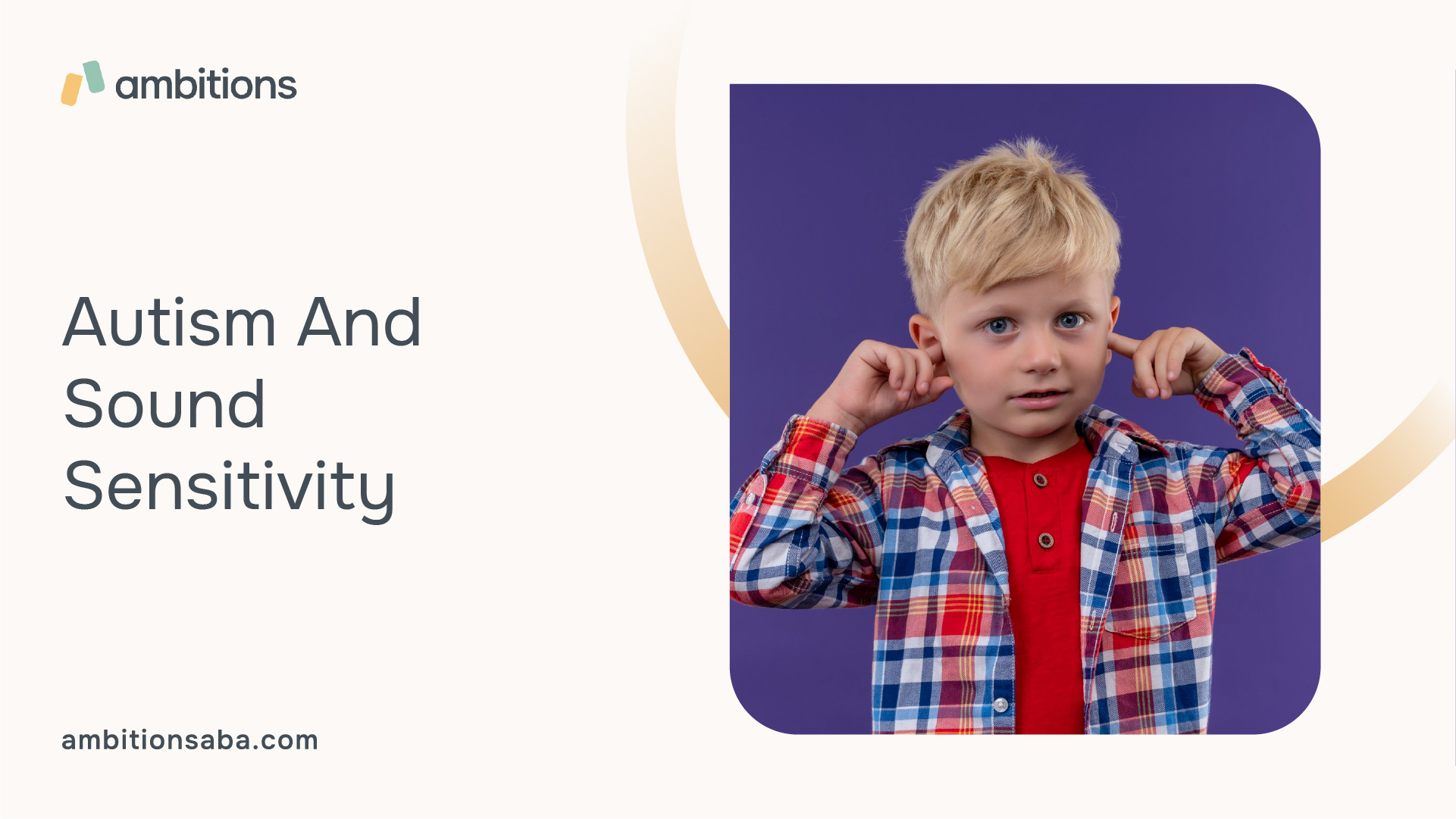Unifying Forces: The Role of Teamwork in ABA Therapy
Autism And Sound Sensitivity
Being sensitive to sounds is a common experience for many people. However, for those with autism, sound sensitivity can be a debilitating and overwhelming experience. First, we to understand what autism is and how it relates to sound sensitivity.

What is Autism?
Autism, also known as Autism Spectrum Disorder (ASD), is a neurodevelopmental disorder that affects an individual's social interaction, communication, and behavior. It is characterized by a wide range of symptoms and is considered a spectrum disorder because it affects each person differently. Individuals with autism may have difficulty with social interactions, exhibit repetitive behaviors, and may have sensory sensitivities.

Sound Sensitivity and Autism
One common sensory sensitivity experienced by individuals on the autism spectrum is sound sensitivity, also known as auditory sensitivity or hyperacusis. This means that individuals with autism may have heightened sensitivity to certain sounds, making them more susceptible to becoming overwhelmed or distressed in noisy or chaotic environments.
Sound sensitivity can vary from person to person with autism. While some individuals may be sensitive to specific frequencies or types of sounds, others may experience sensitivity across a wider range of auditory stimuli. This sensitivity can lead to discomfort, anxiety, and a reduced ability to focus or engage in activities.
It's important to note that sound sensitivity is not exclusive to autism and can also occur in individuals without an autism diagnosis. However, it is more prevalent in individuals on the autism spectrum. Understanding and addressing sound sensitivity is essential in supporting individuals with autism and creating environments that promote their well-being and comfort.
By understanding the unique challenges faced by individuals with autism and their heightened sensitivity to sound, we can explore strategies and interventions to help mitigate the impact of sound sensitivity and create a more supportive environment for individuals on the autism spectrum.
Impact of Sound Sensitivity on Individuals with Autism
Individuals with autism often experience heightened sensitivity to sounds, which can significantly impact their daily lives. Understanding the common reactions to sound sensitivity and the challenges faced by individuals with autism is crucial in providing appropriate support and accommodations.
Common Reactions to Sound Sensitivity
Sound sensitivity, also known as auditory hypersensitivity, can trigger various reactions in individuals with autism. These reactions may include:
- Covering ears or trying to block out the sound
- Becoming agitated, anxious, or distressed
- Exhibiting signs of discomfort, such as grimacing or fidgeting
- Displaying avoidance behaviors, such as leaving the room or covering the ears
- Reacting with emotional outbursts or meltdowns
- Experiencing difficulty concentrating or focusing on tasks
Understanding these common reactions helps caregivers and educators recognize when sound sensitivity is affecting an individual with autism. By identifying these reactions early on, appropriate strategies and accommodations can be implemented to mitigate the impact of sound sensitivity.
Challenges Faced by Individuals with Autism and Sound Sensitivity
Sound sensitivity poses several challenges for individuals with autism. These challenges can significantly impact their daily lives, social interactions, and overall well-being. Some of the key challenges include:
- Sensory Overload: Individuals with autism may experience sensory overload due to the overwhelming nature of certain sounds. This can lead to increased stress levels, difficulties in processing information, and a decreased ability to focus or engage in activities.
- Communication and Social Interactions: Sound sensitivity can interfere with communication and social interactions. Background noises, loud environments, or sudden sounds may make it challenging for individuals with autism to engage in conversations, follow instructions, or participate in group activities.
- Academic Performance: Sound sensitivity can negatively impact academic performance. In a noisy classroom setting, individuals with autism may struggle to concentrate, leading to difficulties in learning and retaining information. Providing a quiet and supportive learning environment is crucial to help optimize academic success.
Recognizing and addressing these challenges through appropriate strategies and accommodations can enhance the quality of life for individuals with autism. Implementing interventions that target sound sensitivity can improve their overall well-being and facilitate their participation in various environments.
Strategies for Managing Sound Sensitivity
For individuals with autism who experience sound sensitivity, implementing strategies to manage and minimize distressing auditory stimuli is crucial. By creating a calm and safe space, utilizing noise-canceling devices and headphones, and incorporating sensory integration techniques, individuals with autism can better cope with sound sensitivity.
Creating a Calm and Safe Space
Creating a calm and safe space is essential for individuals with autism who are sensitive to sound. This space should provide a soothing environment with minimal auditory distractions. Consider the following strategies:
- Designated Quiet Area: Designate a specific area in the home or classroom where the individual can retreat to when overwhelmed by sound. Equip this area with comfortable seating, soft lighting, and calming sensory objects.
- Soundproofing: Implement soundproofing techniques, such as using heavy curtains, rugs, or acoustic panels, to reduce external noise and create a quieter environment.
- Visual Cues: Use visual cues, such as signs or symbols, to indicate when the area is designated as a quiet space. This helps others understand the need for reduced noise levels.
Noise-Canceling Devices and Headphones
Noise-canceling devices and headphones can be invaluable tools for individuals with autism who are sensitive to sound. These devices help block or reduce external noises, allowing the individual to focus and feel more comfortable in various environments. Consider the following options:
- Noise-Reducing Headphones: Noise-reducing headphones are specifically designed to minimize the impact of loud or overwhelming sounds. They can be worn comfortably and provide a physical barrier to reduce auditory input.
- White Noise Machines: White noise machines emit a consistent, soothing sound that can help mask or blend with surrounding noises, creating a more calming environment. These machines can be particularly helpful during sleep or in situations where sudden or unpredictable sounds are common.
Sensory Integration Techniques
Sensory integration techniques are effective strategies for managing sound sensitivity in individuals with autism. These techniques aim to help individuals process and regulate sensory information more effectively. Consider the following approaches:
- Deep Pressure Techniques: Deep pressure techniques, such as weighted blankets or compression garments, can provide a calming effect and help individuals feel more grounded when confronted with sound sensitivity. The deep pressure helps to regulate sensory input and promote relaxation.
- Visual Supports: Visual supports, such as visual schedules or timetables, can assist individuals with understanding and anticipating auditory stimuli. By providing a visual representation of upcoming events or transitions, individuals can mentally prepare for potential sound triggers.
- Social Stories and Role-Playing: Social stories and role-playing activities can help individuals with autism develop coping mechanisms for sound sensitivity. These tools provide a structured and narrative-based approach to understanding and managing challenging auditory situations. They can be personalized to address specific sound-related scenarios.
By implementing these strategies, individuals with autism can better navigate their sound sensitivity and create a more comfortable environment. However, it's important to remember that each individual is unique, and what works for one person may not work for another. It may be beneficial to consult with professionals or therapists specializing in autism and sensory issues to develop individualized support plans.
Developing Coping Mechanisms
Individuals with autism who experience sound sensitivity can benefit from developing coping mechanisms to navigate their sensory challenges. Here are some strategies that can help manage sound sensitivity and promote a sense of calm.
Deep Pressure Techniques
Deep pressure techniques involve applying gentle, firm pressure to the body, which can have a calming effect on individuals with autism. This can be achieved through activities such as weighted blankets, hugs, or deep pressure massages. The deep pressure helps to provide proprioceptive input, which can reduce anxiety and increase body awareness. It is important to introduce these techniques gradually and ensure that they are comfortable for the individual.
Visual Supports
Visual supports can be instrumental in helping individuals with autism cope with sound sensitivity. Visual supports can include visual schedules, social stories, and visual aids that provide information and guidance. These visual tools help individuals understand and anticipate what will happen in different situations, reducing anxiety and promoting a sense of control. Incorporating visual supports can be particularly helpful when preparing for noisy events or when transitioning from one environment to another.
Social Stories and Role-Playing
Social stories and role-playing are effective tools for individuals with autism to understand and navigate challenging situations related to sound sensitivity. Social stories are short narratives that provide specific information about a particular situation or event, helping individuals understand what to expect and how to respond. Role-playing involves acting out scenarios, allowing individuals to practice appropriate responses and develop coping strategies in a safe and supportive environment. These techniques can be used to prepare individuals for potentially overwhelming auditory experiences and provide them with strategies to manage their reactions.
By incorporating deep pressure techniques, visual supports, and social stories into daily routines, individuals with autism and sound sensitivity can develop effective coping mechanisms. These strategies provide support and promote self-regulation, helping individuals navigate their sensory challenges with greater comfort and confidence.
To further address sound sensitivity in individuals with autism, noise-canceling devices and headphones designed specifically for individuals with sensory sensitivities can be beneficial. These devices reduce external noise and provide a more controlled auditory environment, allowing individuals to engage in activities without feeling overwhelmed. Collaborating with professionals, such as therapists and specialists, can also provide valuable guidance in developing personalized coping mechanisms.
Collaborating with Professionals
When it comes to managing sound sensitivity in individuals with autism, collaborating with professionals can be immensely helpful. Therapists and specialists who specialize in autism can offer valuable guidance and support. In this section, we will explore some key aspects of collaborating with professionals to address sound sensitivity in autism.
Working with Therapists and Specialists
Therapists and specialists play a crucial role in helping individuals with autism navigate their challenges, including sound sensitivity. Occupational therapists, speech therapists, and behavioral therapists are professionals who often work closely with individuals on the autism spectrum.
Occupational therapists can assist in developing sensory integration techniques to help individuals regulate their responses to sound. Speech therapists can work on communication strategies to express discomfort or preferences related to sound sensitivity. Behavioral therapists can help individuals learn coping mechanisms and develop appropriate responses to sound triggers.
Collaborating with these therapists and specialists allows for a comprehensive approach to managing sound sensitivity and other sensory issues associated with autism. They can provide tailored strategies and interventions based on the individual's specific needs and strengths.
Individualized Support Plans
An essential part of collaborating with professionals is developing individualized support plans for individuals with autism and sound sensitivity. These plans take into account the unique challenges and preferences of the individual, providing a framework for addressing sound sensitivity in a personalized manner.
Individualized support plans may include specific strategies and accommodations tailored to the individual's needs. This can involve creating a calm and safe space, utilizing noise-canceling devices or headphones, and implementing sensory integration techniques. The support plan should be regularly reviewed and modified as needed to ensure its effectiveness.
Advocacy and Education
Another important aspect of collaborating with professionals is engaging in advocacy and education. Professionals can provide parents and caregivers with information and resources to better understand sound sensitivity in autism. This knowledge empowers them to advocate for their child's needs and rights in various environments, such as schools, community settings, and healthcare settings.
Professionals can guide parents on how to effectively communicate with educators, healthcare providers, and other relevant individuals about their child's sound sensitivity. By raising awareness and promoting understanding, parents can help create an inclusive environment that supports individuals with autism and their unique sensory needs.
Remember, every individual with autism and sound sensitivity is unique, so it's crucial to work closely with professionals and tailor the support to the individual's specific needs. By collaborating with therapists and specialists, developing individualized support plans, and advocating for your child's needs, you can create a positive and supportive environment that helps individuals with autism thrive.
FAQs
Can sound sensitivity be cured?
There is no known cure for sound sensitivity. However, there are many strategies and techniques that can help individuals with autism manage their sensitivity to sounds.
Is sound sensitivity the same as misophonia?
No, sound sensitivity and misophonia are not the same thing. Misophonia is a condition where an individual has a strong emotional or physical response to specific sounds like chewing, breathing, or tapping.
What other sensory sensitivities do individuals with autism experience?
Individuals with autism can experience hypersensitivity or hyposensitivity to touch, taste, smell, and sight in addition to sound sensitivity.
Can medication help with sound sensitivity?
There is currently no medication specifically designed to treat sound sensitivity. However, some medications used for anxiety or depression may help reduce the symptoms of sound sensitivity.
Should I force my child with autism to tolerate loud noises?
No, it is important not to force an individual with autism to tolerate loud noises. This can cause them significant distress and lead to sensory overload. Instead, use strategies like noise-cancelling headphones or earplugs to help reduce the intensity of sounds that cause discomfort.
Summary
Sound sensitivity can be a challenging experience for individuals with autism. However, with proper management strategies, it is possible to reduce the impact of sound sensitivity on their lives. By identifying triggers, creating a safe space, using noise-cancelling headphones or earplugs, using visual aids, and seeking professional help, individuals with autism can lead a better quality of life. Remember, everyone deserves to feel comfortable and safe in their environment.

